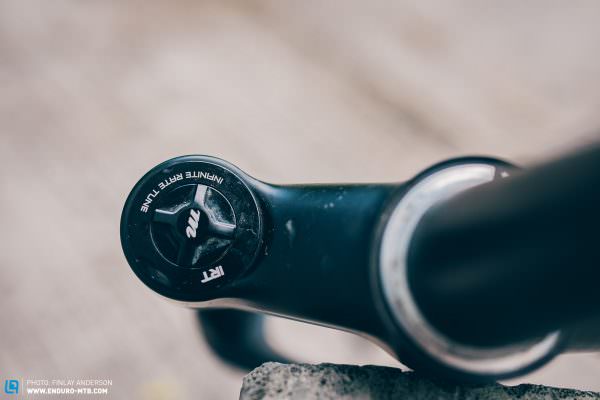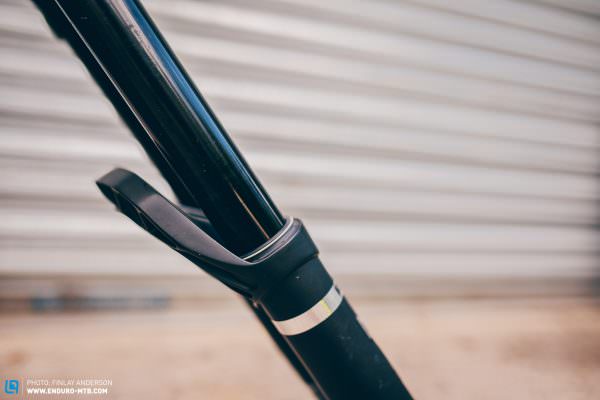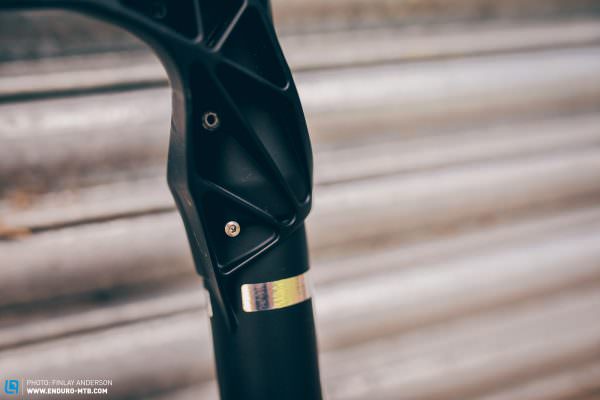With three air chambers, the Manitou Mezzer PRO rides impressively tall in its travel and takes tuning to the next level. But can you have too much adjustability and does this fork fill the gap between conventional and super burly forks?

Launched last year, the Manitou Mezzer was the first fork to push the enduro category beyond 36 mm. With burly 37 mm stanchions and the signature reverse arch design, the Mezzer means business. The unique design means the arch can sit lower, requiring less material to maintain the same strength. That shows on the scales, with the fork weighing just 2.1 kg. The Mezzer PRO is available in both wheel sizes and travel is easily adjusted internally from 140 mm to 180 mm in 10 mm increments using the supplied spacers. Inside, the Mezzer has some very unique technology. That starts with the hydraulic bottom-out bumper that kicks in for the last 25–30 mm of travel. This is more advanced than a traditional elastomer bumper, relying on the velocity of the shaft to react more stiffly the faster the shaft speed. Undeniably, the heart of the Manitou fork is the IRT (Infinite Rate Tune) chamber. The IRT is an additional air chamber that sits above the positive air chamber. At a higher pressure, the IRT piston applies force on the main chamber affecting its spring rate. IRT is a little like adding tokens but much more dynamic, giving control over the feel of the mid-stroke independent of the initial sensitivity. The latest model we have now also features two ‘Trail Side Relief’ screws on the rear of the casting. Undoing these allows the internal pressure to be released in the case of big altitude changes, just like the FOX 36 and 38. Unfortunately for a big hit fork, the Manitou Mezzer is not certified for use with a 220 mm rotor. The fork uses a Hexlock SL2 axle, which requires a 6 mm allen key to operate.


Setup of the Manitou Mezzer PRO
Have you wondered why we haven’t published a Mezzer review yet? It’s because our first experiences with the Manitou Mezzer PRO were less than positive and we had to return a number of forks for warranty with bushing play issues. Manitou seems to be on top of the issue now and our latest fork has been trouble-free. When it comes to setting up the Mezzer, you need to throw the old rule book out of the window and pay attention to Manitou’s guidance. With three air chambers all running relatively low pressures, you need to be accurate with your shock pump – when your main spring pressure is only 50 psi, 5 psi errors are very significant. If you’re a near enough rider, then your suspension setup will be all over the place. The location of the equalisation ports mean you also need to make sure the fork is not weighted when pumping it up, to the point of physically extending the fork. It did take a little longer to get the Mezzer how we liked it. We found the fork to be very sensitive to changes in IRT pressure. Moving from 80 to 90 psi in the IRT (main chamber 58 psi) results in a dramatic increase in mid-stroke support which comes in quite early in the travel. The IRT tuning system has a much bigger impact than any token system available on the other forks, allowing you to go from very linear to VERY progressive and firm. However, care needs to be taken with the pressures to keep everything balanced. It’s not difficult but certainly more of a fork for those who like to dedicate time to set up.
The fork looks fantastic. The retro graphics combined with the huge 37 mm stanchions and neat and compact arch looks superb.
The Manitou Mezzer PRO on the trail
Once set up, the Manitou Mezzer is a great fork with some unique highlights on the trail. When you start hitting the turns, support from the fork is unquestionable. The IRT works exceptionally well keeping the fork high in the travel, higher than any other fork in the test, providing a stable platform through steep turns and under hard braking. The chassis of the fork is stiff and powerful, more so than the FOX 36 and on par with the RockShox Lyrik. It turns in with authority and is capable of holding a hard line if you have the strength to keep it on track. Through the biggest hits, the Mezzer PRO feels extremely confident, soaking up square edges without complaint and running to the end of its travel smoothly and seamlessly, we assume due to the hydraulic bumper. However, even after a number of days increasing and decreasing the pressures and tuning the high- and low-speed compression adjustment, we found that while we could achieve a supportive and racy feel, we struggled to get the same balanced small bump compliance and grip we experienced with the FOX and RockShox forks. We felt that the damping never quite allowed the extreme sensitivity that is found in the leaders of the sector. Racers and powerful riders generating bigger forces will like this fork the most.
We felt that the damping never quite allowed the sensitivity that is found in the leaders of the sector. However, the huge support on offer suits racers and heavier riders best.


How does the Manitou Mezzer compare to the competition?
The Manitou Mezzer PRO is a great looking fork, sitting in a sweet spot when it comes to chassis stiffness and compliance. This translates to less fatigue compared to a ZEB or FOX 38 but still enough ‘plow-through’ composure. Compared to the other forks in the test, with two adjustable air chambers that are strongly coupled, the Manitou Mezzer was the hardest fork to set up correctly, involving the most setup time. Once dialled in, the Mezzer PRO was a great performer with huge support, sitting just behind FOX and RockShox when it comes to grip and sensitivity. Using similar technology to Öhlins, the ride is similar too and more suited to powerful riders who can generate big forces and make the most of the mid-stroke support on offer.
In conclusion
The Manitou Mezzer PRO takes a very different approach to set up and needs more time to reach its optimum performance. Tuners or those who like a particular setup will love the Manitou Mezzer as it offers almost unlimited control. For heavy riders the chassis offers the right compliance. We found we could dial in huge mid-stroke support without compromising the end of travel but we never managed to get the same small bump compliance as the leading forks in the test.
Tops
- infinite tuning options
- great mid and end stroke control
- lightweight and compliant
Flops
- more involved setup
- sensitivity is ok but not great
For more information, check out the Manufacturer’s website. If you want to learn more about mountain bike forks and see how the Manitou Mezzer PRO stacks up against the competition, https://enduro-mtb.com/en/best-mountain-bike-suspension-fork-2021-review/
All forks on test: DVO Onyx SC D1 | FOX 36 2021 Grip2 Factory | FOX 38 2021 Grip2 Factory | Manitou Mezzer PRO | Marzocchi Bomber Z1 Coil | MRP Ribbon Coil | Öhlins RXF36 M2 Air | RockShox Lyrik Ultimate 2021 | RockShox ZEB Ultimate
Did you enjoy this article? If so, we would be stoked if you decide to support us with a monthly contribution. By becoming a supporter of ENDURO, you will help secure a sustainable future for high-quality mountain bike journalism. Click here to learn more.
Words: Photos: Finlay Anderson









